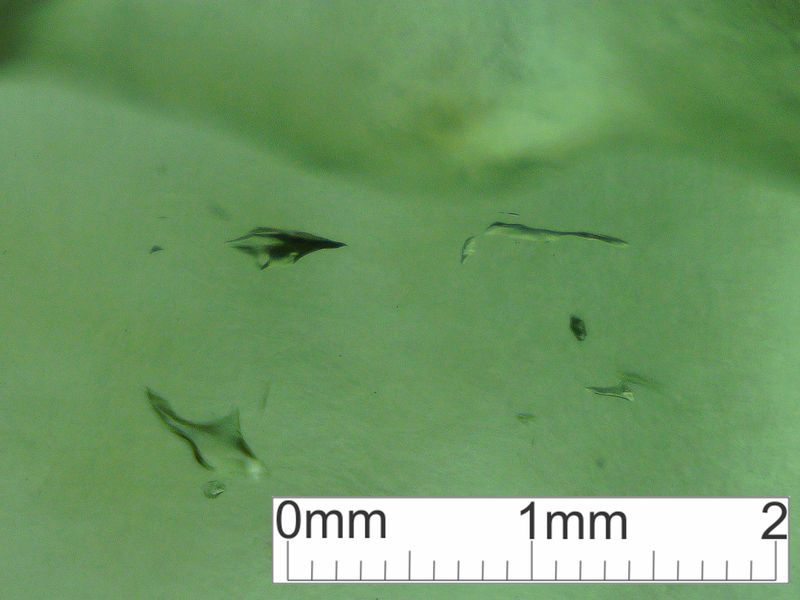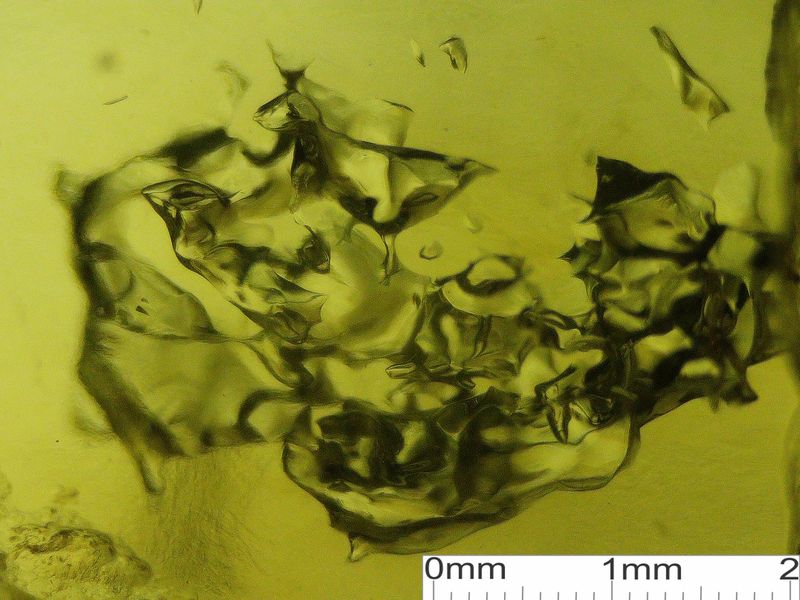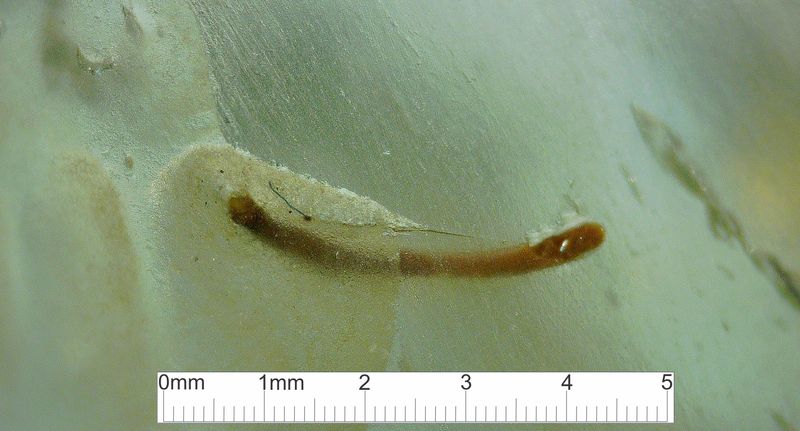| View previous topic :: View next topic |
| Author |
Message |
Craig Hagstrom
Joined: 10 Jan 2025
Posts: 22


|
 Posted: Jun 10, 2025 21:28 Post subject: Re: Libyan Desert Glass Structure Posted: Jun 10, 2025 21:28 Post subject: Re: Libyan Desert Glass Structure |
|
|
Here's a totally fascinating development. I have a couple pieces that in my last pdf I said were good candidates for having chains of sand grains, based on their overall shapes. I ground a flat on each of them and am finding these terrific bubbles.
If these bubbles formed in molten glass they might be round, they might be teardrops, they might (if the molten glass flowed) be elongated. But this are none of those things. The best explanation is that these are air left in the interstices between sand grains. That means this material was never molten. As I've conjectured, this formation implies the solid grains were wetted by fluidized silica wicking into the unmelted sand. This is the fingerprint of beta radiation.
When the fluid silica flowed into the sand, some air couldn't get out of the way. There are some tiny bubbles, but two of these images show air bubbles about a quarter inch across, with much of the volume filled by sand. The sand itself is invisible here, so you're seeing only the interstices. You might have to hold your mouth right before it starts to make sense. :)
This is further evidence that this material was never molten. Melted sand has the consistency of honey, more or less. But beta-radiation fluidized silica seems to have a viscosity closer to water.
If there is an alternate explanation for this formation, I'm very interested in hearing it.
| Description: |
|
| Viewed: |
464 Time(s) |

|
| Description: |
|
| Viewed: |
464 Time(s) |

|
| Description: |
|
| Viewed: |
464 Time(s) |

|
|
|
| Back to top |
|
 |
Craig Hagstrom
Joined: 10 Jan 2025
Posts: 22


|
 Posted: Jun 30, 2025 11:52 Post subject: Re: Libyan Desert Glass Structure Posted: Jun 30, 2025 11:52 Post subject: Re: Libyan Desert Glass Structure |
|
|
Here's a neat fossil, first one like this I've seen. Appears to be something like a berry stem. I found it partly chopped off while grinding this face down to polish it and get a better look inside. As I finish polishing, this fossil is going to be largely wiped out, so I took a picture as is.
If a total amateur like me can find these so easily, there must be hundreds of thousands of fossils in LDG specimens out there. I'm guessing they're just dismissed as blemishes. Amazing.
| Description: |
|
| Viewed: |
68 Time(s) |

|
|
|
| Back to top |
|
 |
marco campos-venuti

Joined: 09 Apr 2014
Posts: 231
Location: Sevilla



|
 Posted: Jun 30, 2025 12:24 Post subject: Re: Libyan Desert Glass Structure Posted: Jun 30, 2025 12:24 Post subject: Re: Libyan Desert Glass Structure |
|
|
Dear Creg, I admire the perseverance and illusion you put into your study.
However, you cannot hunt for fossils inside a glass that was formed at temperatures estimated to be above 2750°C. If the rocks around the impact have been sublimated you cannot find any trace of the primary structures of the sand nor traces of organisms. Reidite has been found in LDG and is an indicator of HPHT only found associated with meteorite impacts.
|
|
| Back to top |
|
 |
Craig Hagstrom
Joined: 10 Jan 2025
Posts: 22


|
 Posted: Jun 30, 2025 13:07 Post subject: Re: Libyan Desert Glass Structure Posted: Jun 30, 2025 13:07 Post subject: Re: Libyan Desert Glass Structure |
|
|
| marco campos-venuti wrote: | Dear Creg, I admire the perseverance and illusion you put into your study.
However, you cannot hunt for fossils inside a glass that was formed at temperatures estimated to be above 2750°C. If the rocks around the impact have been sublimated you cannot find any trace of the primary structures of the sand nor traces of organisms. Reidite has been found in LDG and is an indicator of HPHT only found associated with meteorite impacts. |
As I mentioned, zircon has been found in fulgurites and can no longer be diagnostic of impact events. I don't know how reidite stands re that question. Regardless, a number of impact craters have been identified in the general area of the LDG deposit and might be a source of zircon/reidite..
All that aside, when we keep finding fossils in LDG, at some point we have to ask whether the presumption of high pressure and temperature is wrong. Beta radiation fluidizes silica, and resolves the fossil/LDG conundrum. Far as I know, beta radiation itself does not resolve the zircon/reidite question, but it's not my field.
I'm presenting evidence I'm finding. I'm always interested in an alternate explanation for what I'm seeing.
|
|
| Back to top |
|
 |
marco campos-venuti

Joined: 09 Apr 2014
Posts: 231
Location: Sevilla



|
 Posted: Jun 30, 2025 14:39 Post subject: Re: Libyan Desert Glass Structure Posted: Jun 30, 2025 14:39 Post subject: Re: Libyan Desert Glass Structure |
|
|
| Still the ignition temperature of a seed is in the order of 2-300 C and melting point of glass is around 800 C.
|
|
| Back to top |
|
 |
Craig Hagstrom
Joined: 10 Jan 2025
Posts: 22


|
 Posted: Jun 30, 2025 14:52 Post subject: Re: Libyan Desert Glass Structure Posted: Jun 30, 2025 14:52 Post subject: Re: Libyan Desert Glass Structure |
|
|
| marco campos-venuti wrote: | | Still the ignition temperature of a seed is in the order of 2-300 C and melting point of glass is around 800 C. |
When silica is fluidized by beta radiation, the melting point is immaterial.
|
|
| Back to top |
|
 |
|





